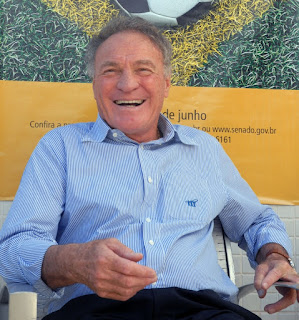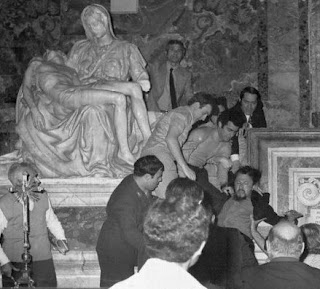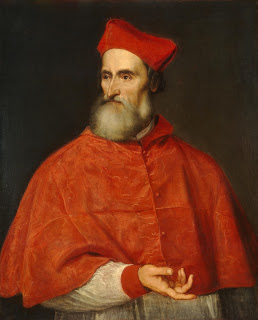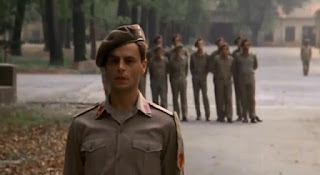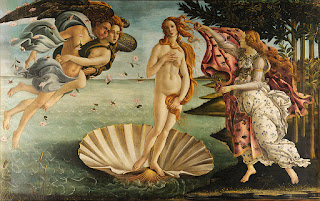Sicilian lawyer made life's work of taking on Cosa Nostra
 |
Giovanni Falcone (left), pictured with his fellow anti-Mafia
magistrate Paolo Borsellino. Both were murdered in 1992 |
Giovanni Falcone, who would become known as an anti-Mafia crusader during his career as a judge and prosecuting magistrate, was born on this day in 1939 in Palermo.
The son of a state clerk, he was raised in a poor district of the Sicilian city. Some of the boys with whom he played football in the street would go on to become Mafiosi but Falcone was determined from an early age that he would not be drawn into their world.
Educated at the local high school, he studied law at Palermo University. In 1966, at the age of 27, he was appointed a judge in
Trapani, a crime-ridden port on the west coast of Sicily and began his lifelong quest to defeat the criminal organisation.
In time, Falcone became the Mafia's most feared enemy and by 1987, when he was the chief prosecutor at the so-called 'maxi-trial' in
Palermo which convicted 342 members of the so-called Cosa Nostra, the likelihood he would be murdered meant he could not leave home without a heavily armed police escort.
He worked in a bomb-proof bunker underneath the city's law courts. His home was similarly protected and when he travelled between the two it was with a convoy of armoured police cars.
Yet he refused to be cowed, even when a wave of Mafia reprisals led to the deaths of many of his colleagues. The first was Gaetano Costa, Palermo's chief magistrate, who was murdered shortly after signing 80 arrest warrants for Mafia bosses that Falcone's investigations had linked to mobsters in America.
The assassination of Boris Giuliano, the Head of Police in Palermo, soon followed, after which Falcone was assigned to a select pool of anti-Mafia judges and prosecutors.
In 1982
Carlo Alberto Dalla Chiesa, the carabinieri general who had smashed the Red Brigades, was despatched to Palermo to co-ordinate Rome's anti-Mafia policy. Only 100 days after taking office, he was machine-gunned to death in the street.
Falcone became effective head of the anti-Mafia drive after its co-ordinator, Judge Rocco Chinnici, was blown up by a car bomb in July 1983.
His work led to the dramatic 'maxi-trial' of 1986-87, in which 8,000 pages of evidence, much of it based on information passed on by
pentiti - the Mafiosi turned informants - led to the conviction of 342 gang members.
They received sentences totalling 2,665 years in prison, including 19 life sentences, although the success of the operation was much undermined when all bar around 30 of those found guilty were later released on appeal, with doubts expressed over the validity of testimony from informants.
After the 'maxi-trial', Falcone had hoped to be appointed chief prosecutor in Palermo but was denied the opportunity.
Instead, he took a position in Rome with the
Ministry of Justice, where he was successful in preparing a decree that overturned the judgment of the Supreme Court to quash so many of the 'maxi-trial' convictions and led to the re-arrest of many Mafia bosses. In another judgment by the Supreme Court, in January 1992, the original convictions were upheld.
Falcone died four months later, on one of the visits to his home in Palermo he made every week. He was killed when a half-ton of explosives was detonated under a section of the coastal motorway he always used on his way from the airport. His wife, Francesca, died with him, along with three police officers.
The assassination had been ordered by the head of the Corleonesi faction of the Sicilian Mafia,
Salvatore "Toto" Riina, who was arrested the following year and jailed for life. Less than two months after Falcone's death, his friend and close associate in the anti-Mafia fight, the magistrate
Paolo Borsellino, was killed by a car bomb in Palermo.
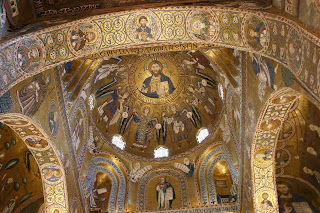 |
Gold mosaics line the ceilings of the Cappella Palatina,
one of Palermo's main tourist attractions |
Travel tip:
Despite its inevitable association with the criminal underworld,
Palermo is an attractive tourist destination, a vibrant city with a wealth of history, culture, art, music and food. It has many outstanding restaurants as well as fine examples of Romanesque, Gothic and Baroque churches, palaces and buildings. Top attractions include the extraordinary
Cappella Palatina, featuring Byzantine mosaics decorated with gold leaf and precious stones.
Travel tip:
Sicily's most famous coastal resort is the clifftop town of
Taormina, overlooking the Ionian coast. Full of restaurants and shops, with beaches nearby, it is rich in history. The Greek amphitheatre, with its panoramic view of Mount Etna and the coast, is used for concerts and plays, and the town's old streets are enclosed within medieval walls.
(Photo from Cappella Palatinia by Woodguy CC BY-SA 3.0)
Home



